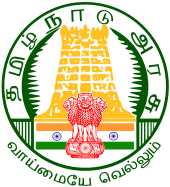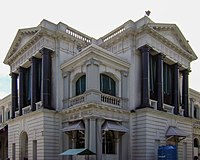
Back तमिल नाडु विधानसभा AWA האספה המחוקקת של טמיל נאדו HE तमिलनाडु विधान सभा Hindi Թամիլ Նադուի օրենսդիր ժողով Armenian तमिळनाडू विधानसभा Marathi தமிழ்நாடு சட்டப் பேரவை Tamil తమిళనాడు శాసనసభ Tegulu
Tamil Nadu Legislative Assembly | |
|---|---|
| 16th Tamil Nadu Assembly | |
 | |
| Type | |
| Type | |
Term limits | 5 years |
| Leadership | |
R. N. Ravi since 18 September 2021 | |
Deputy Speaker | |
Deputy Leader of the Opposition | |
| Structure | |
| Seats | 234 |
Political groups | Government (158)
Official Opposition (62)
Other opposition (13) Vacant (1)
|
| Elections | |
| First past the post | |
First election | 27 March 1952 |
Last election | 6 April 2021 |
Next election | May 2026 |
| Meeting place | |
 | |
| 13°04′47″N 80°17′14″E / 13.0796°N 80.2873°E Chief Secretariat of Tamil Nadu, Chennai, Tamil Nadu | |
| Website | |
| www | |
| This article is part of a series on the |
| Politics of Tamil Nadu |
|---|
 |
The Tamil Nadu Legislative Assembly is the unicameral legislature of the Indian state of Tamil Nadu. It has a strength of 234 members, all of whom are democratically elected using the first-past-the-post system. The presiding officer of the Assembly is the Speaker. The term of the Assembly is five years, unless dissolved earlier.
Since Tamil Nadu has a unicameral legislature, the terms Tamil Nadu Legislature and Tamil Nadu Legislative Assembly are almost synonymous and are often confused. However, they are not one and the same. The Tamil Nadu Legislature is the legislative body, while the Tamil Nadu Legislative Assembly is a part of it. The Tamil Nadu Legislative Assembly, along with the Governor of Tamil Nadu, constitutes the Tamil Nadu Legislature.
The present state of Tamil Nadu is a residuary part of the erstwhile Madras Presidency and was formerly known as Madras State. The first legislature of any sort for the Presidency was the Madras Legislative Council, which was set up as a non-representative advisory body in 1861. In 1919, direct elections were introduced with the introduction of diarchy under the Government of India Act 1919. Between 1920 and 1937, the Legislative Council was a unicameral legislature for the Madras Presidency. The Government of India Act 1935 abolished diarchy and created a bicameral legislature in the Madras Presidency. The Legislative Assembly became the Lower House of the Presidency.
After the Republic of India was established in 1950, the Madras Presidency became the Madras State, and the bicameral setup continued. The Madras State's assembly strength was 375, and the first assembly was constituted in 1952. The current state was formed in 1956 after the reorganisation of states, and the strength of the assembly was reduced to 206. Its strength was increased to the present 234 in 1965. Madras State was renamed Tamil Nadu in 1969, and subsequently, the assembly came to be called the Tamil Nadu Legislative Assembly. The Legislative Council was abolished in 1986, making the legislature a unicameral body and the assembly its sole chamber.
The present Sixteenth Legislative Assembly was constituted on 3 May 2021. It was constituted after the 2021 assembly election, which resulted in the Dravida Munnetra Kazhagam (DMK)-led front winning and forming the government. The next election will take place in 2026.

